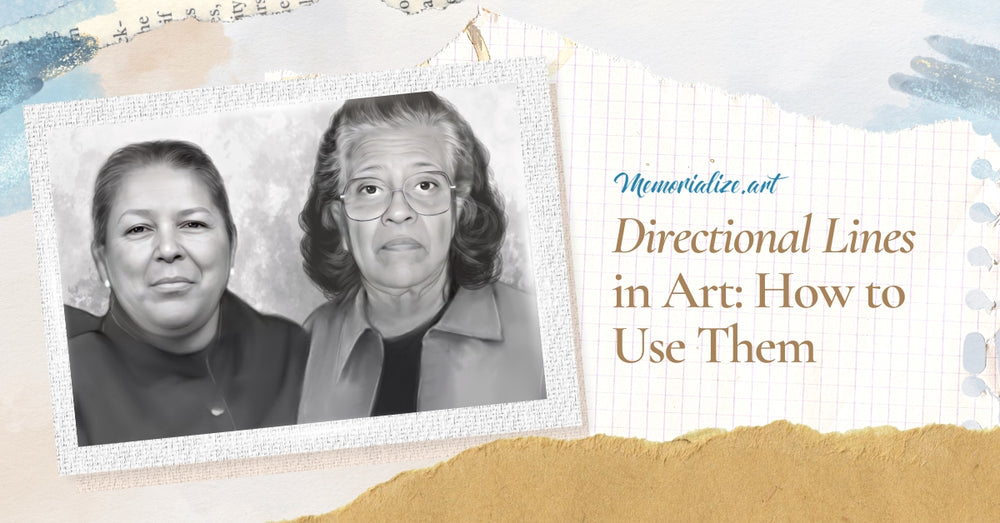Directional Lines In Art: How to Use Them

Aside from bright colors and expressions, have you noticed the use of directional lines in art in Van Gogh's Starry Night and Piet Mondrian's Composition II? These artworks are wonderful examples of how expressive lines direct the viewer's eye, show movement, and make people feel something when they look at their pieces.
So, what is a line in art and how are they used? This article will help you understand an art line, how directional lines are used, their types, and excellent examples.

What Are Directional Lines
Directional lines lead the eye through artwork and draw attention to certain parts or focus points. This basic art element can create a sense of flow, rhythm, and energy, which changes the piece's general mood and feel.
A directional line drawing may have vertical, horizontal, diagonal, curved, zigzag, spiral, and broken lines. Each has distinct aesthetic traits and may convey different emotions, mainly when used in a graduation pencil drawing.
Why Are Directional Lines in Art Important?
Depending on their orientation and arrangement, lines can create a feeling of motion, rhythm, or dynamism. These can also greatly enhance the overall composition and balance of an artwork.
These basic elements can achieve a visual balance and ensure that each element of design cohesively interact with the compositions.
Types of Directional Lines

Understanding the types and functions of lines will deepen an art enthusiast's appreciation for the art. Artists may have the power to transform a white space into vibrant narratives, like a family pencil drawing, that captivate and engage the viewer.
Diagonal Lines
A diagonal line in art is slanted in form to convey movement or emphasis. It can be employed in various ways, whether to suggest the sweeping motion of a figure in action, the tilt of a landscape, or the angular structure of architectural elements.
Horizontal Lines
The horizon is the reference point for horizontal lines. This basic form of a line can symbolize a vast landscape, a body of water, or a solid base. It creates a visual element of movement from one point to another.
Vertical Lines
The vertical line definition in art is a rising straight line from the base of a digital painting or a piece of paper. They form a visual anchor in a picture, drawing the viewer's attention upward and stressing height and loftiness.
Curved Lines
The degree of curve in these lines evokes a sense of softness, elegance, and gentle motion. Curved lines are generally used to show the contours of a landscape, the graceful curves of a human form of line art, or the delicate arcs of a flower arrangement.
Contour Lines
Contour lines follow the edge of a subject. It plays a significant role in defining the shape, form, and structure of the line orientation in art. Contour lines provide delicate or bold compositions, capturing a figure's intricacies or a brushstroke's gestural movement within a dynamic piece.
Examples of Directional Lines in Art

Many famous artists employ various types of directional lines to evoke specific emotions, emphasize focal points, and enhance the overall visual impact of their artwork. Here are the most famous paintings that used a line orientation in art.
Custom Line Art by Memorialize Art
These custom line arts use directional lines as the primary visual element to represent and define shapes, forms, and contours. These lines can vary in thickness, length, and direction to create various effects and emotions.
Starry Night by Vincent Van Gogh
The swirling lines in the sky and the stars create a dynamic movement. The church steeple drawn with vertical lines helps to ground the viewer in reality despite the airy setting. The dramatic upward movement of the cypress tree in the foreground echoes in the bold diagonal lines.
Composition II in Red, Blue, and Yellow by Piet Mondrian
The solid black vertical and horizontal lines that form a grid in this artwork are the piece's defining characteristics. These lines serve as the principal directional components in the composition and how the canvas is divided into separate rectangular forms.
Techniques for Using Directional Lines in Art
An artist's skill may be improved by learning and applying various methods, whether in painting, drawing, or other visual media. These techniques offer artists many possibilities to experiment with and unleash the expressive potential of directional lines.
Dotted Lines
In dotted directional lines, the artist employs a series of tiny dots to create a line instead of solid lines. These dots are spaced evenly along the desired path of the line to create a visual effect. It may suggest movement, create texture, or add a subtle pattern to the artwork.
Implied Lines
The implied lines technique is a way to make lines look like they are there without drawing them out. It includes using other parts of the composition, like shapes, forms, or items, to make the illusion of lines that the viewer sees.
Cross-Hatching Gesture Lines
Using quick, open, and expressive strokes, you can build up the lines you want in a cross-hatching pattern with the cross-hatching gesture lines technique. In sketches, this method is often used to show color, volume, and form, especially in places with a lot of detail.
Final Thoughts
Artists may lead the viewer's gaze, create movement, express emotions, and achieve visual equilibrium by comprehending diagonal, horizontal, vertical, curved, and contour lines. The deliberate use of directional lines, whatever the type, may completely alter a work of art into something intriguing and unforgettable.
Explore The Uses of Lines With Memorialize Art
Explore works that include the powerful, expressive strokes of a brush or the dynamic movement portrayed through the skilled use of lines. Whether you're looking for a pet portrait or a charcoal drawing of your first home, Memorialize Art uses directional lines to guide the viewer's attention around the elements of art.










